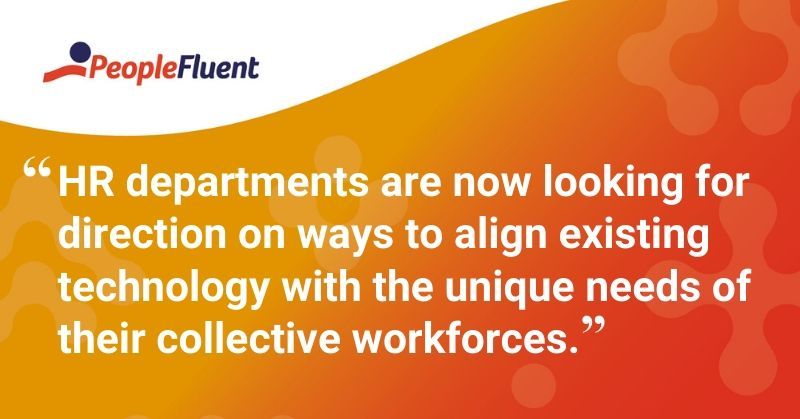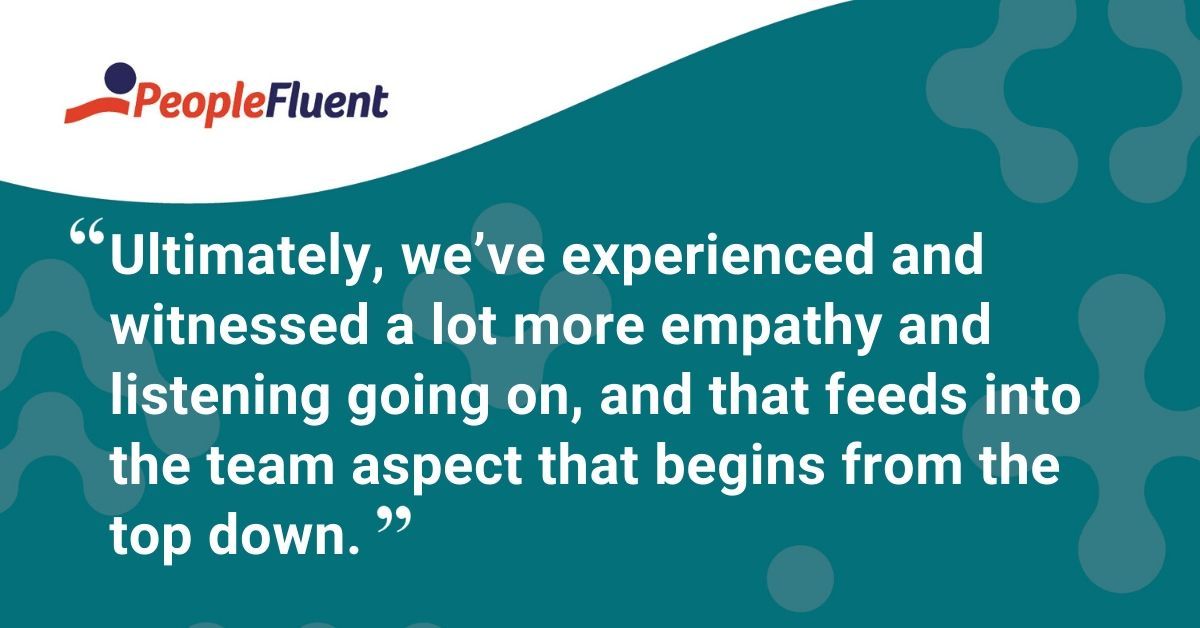Published: Jun 23, 2020Time to read: 6mins Category: Talent Management
How to Leverage Technology to Drive a Productive and Engaged Workforce
With COVID-19 and a changing financial environment, HR professionals are now faced with a variety of new challenges to keep their organization productive and engaged. Based on insights from the PeopleFluent-hosted webinar, ‘The Rise of the CHRO: Q&A Session’, with guests Stephen Bruce, Managing Director at PeopleFluent, David Clift, Chief People Officer at PeopleFluent’s parent company, Learning Technologies Group (LTG), and Jo Kori, Global Learning & Development Manager at LTG, we’ve outlined ways that HR leaders can continue to drive productivity for fully-remote teams by leveraging technology and a new approach to talent management.
According to a recent study by Global Workplace Analytics, it’s estimated that 56% of the US workforce holds a job that is compatible with remote work. The report goes on to mention that one of the biggest reasons managers and executives prefer in-office work over remote-work is trust—or a lack thereof. However, now that a majority of employees have demonstrated the ability to work remotely and remain engaged, some executives may reconsider their approach.
Whether the prolonged work-from-home situation is nearing its end or we’ll be required to continue working remotely, the need for digital transformation has accelerated. HR departments are now looking for direction on ways to align existing technology with the unique needs of their collective workforces.
More from the blog: 'How CHROs Can Maintain a Productive Workforce During Remote Work'
Balancing Talent Strategies and Business Goals
To continue meeting businesses’ goals and ensure their workforces are engaged and productive, HR leaders are in the midst of a delicate balancing act. By restructuring their approach to talent strategies, executives can effectively do both and continue looking at future plans for the company. One of the main considerations from this discussion was how the changes to our performance evaluations may impact succession planning.
Q: How will changes in performance evaluations impact succession planning?
David Clift: For starters, better quality evaluations will provide more force to succession planning. The tools and data will allow for a broader range of leaders to have a meaningful impact on the process. Previously, the succession planning process lost its meaning when it was executed beyond managers with personal knowledge of individual employees. The availability of this higher-quality data allows managers and HR leaders to match skills and performance with succession plans, which ultimately leads to better outcomes for the business and the individual.
Jo Kori: Talent management systems can continue to be a foundational support system for leadership to effectively manage their succession planning. There are many benefits of storing performance evaluation data in a centralized location. A leadership program within the system can help executives identify top performers who should be considered for further development. Additionally, HR can work with L&D to provide offerings with performance-based development.

You might also like: ‘6 Foundations for Effective Succession Planning’
The Importance of Continuous Communications and Feedback
Providing feedback to your teams is an important and expected part of managing an organization. However, without the ability to meet face-to-face with an individual or team, continuous communication is even more critical to keeping employees updated and engaged.
Q: What tools or processes can help leaders manage internal communications and employee feedback?
David Clift: I believe video communications can improve the delivery of information to distributed and remote teams. It adds a human element that we’ve been missing for the last few months as we’ve moved from offices to our homes. Pulse surveys have been invaluable for determining employee engagement, especially at the beginning of our transitions. Having this feedback from employees on a weekly basis helps us tailor our internal communication efforts and ensures we have a repository of feedback that we can act on in order of priority.
Stephen Bruce: We’ve also deployed FAQs into our team collaboration workspace and provided weekly company updates from senior leaders in the business. This team workspace can also be a space to house information on governmental programs or other links to resources that can aid employees. When you think about what your employees may need, remember that a lot of their spouses may be unemployed throughout the pandemic, which leads to more stress and a reduction in engagement. This isn’t necessarily something an individual will come out and say, so a manager won’t have a clear idea of how they’re doing. That’s another reason why we recommend having check-ins via video meetings instead of through email. Non-verbal cues are easier for a manager to pick up on in video chats that they would otherwise have missed in an email or chat.

Related reading: 'Talent Managers: An Advocate for Employees'
Possible Changes to Organizational Structures
While the organizational structures that were in place before COVID-19 have remained mostly the same, there is a possibility we could see them shift. Here’ a look at what that shift may look like.
Q: With the rise of remote workforces, do you see decentralized, team-based organizational structures becoming the new normal?
David Clift: The short answer is yes—it could become the new normal. Our workforces are becoming more self-managed, giving leaders a different perspective on performance and how it should be measured and rewarded. If a challenge is simple enough to be solved by one person then we can probably automate it.
The team, therefore, becomes the minimum viable unit to drive success and solve complex problems so I begin to see methodologies first adopted in the software industry becoming the norm. Spotify’s use of the 'squads and tribes' model and other ways of working that have grown out of an agile approach are becoming more common as we begin to understand that.
We’ve also seen individuals take more ownership over their work hours to ensure they have flexibility to manage the responsibilities of their personal lives. Ultimately, we’ve experienced and witnessed a lot more empathy and listening going on, and that feeds into the team aspect that begins from the top down.
To learn more about how you can manage these changes in your organization, download a recording of the webinar, 'The Rise of the CHRO: Q&A Session'.
Discover How Performance Software Helps Build a Culture of Support
Guide people on a path of continuous improvement, excellence, and achievement. PeopleFluent helps you support your people, so they exceed their goals and drive business outcomes.